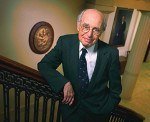In the last 100 years, we have changed the way we live—what we eat and drink, whether and how much we exercise, how we drive, what we inhale. Our shifting lifestyles contribute not only to heart disease but also to cancer, obesity, diabetes, and other conditions that collectively explain about half of all premature deaths in America. Worldwide, noncommunicable diseases are the top killer and on the rise. HSPH researchers have worked to understand the complex factors that steer behavior in unhealthy directions, and what can be done—educationally, medically, even politically—to shift course.
Taking the long view
Don’t smoke. Drink only in moderation. Maintain a healthy weight. Exercise regularly. Eat a diet rich in fruits and vegetables. Don’t overindulge in red meat or butter.
We take most of these prescriptions for a “healthy lifestyle” for granted today. But they were not always so obvious.
Much of what we now know about healthy living is owed to work begun in the first half of the 20th century by HSPH faculty and others using a method known as the longitudinal cohort study. This study teases apart both obvious and hidden risk factors for disease by following a specific group of people over an extended period of time.
The concept of disease “risk factors” itself had its genesis in a famous cohort study called the Framingham Heart Study, which began in 1948 under the auspices of the National Heart Institute (now the National Heart, Lung and Blood Institute) and is currently in its third generation. An earlier example is the 1922–1935 Harvard Growth Study, which yielded some of the first benchmarks for growth and development in healthy children.
Ask a nurse
What would become one of the largest and most important cohort studies examining the role of environment and behavior on disease began modestly in 1976, when a small group of researchers from HSPH, Harvard Medical School, and Brigham and Women’s Hospital, led by HSPH’s Frank Speizer, designed and launched a questionnaire for a small group of female nurses ages 30 to 55. The Nurses’ Health Study’s goal was to clarify the connection between smoking history, use of oral contraceptives, and subsequent disease.
The study soon expanded to include 120,000 female nurses. The questions broadened to include participants’ medical history, health status, and individual habits such as whether they took vitamins or replacement hormones, whether they attended religious services, and how many friends they had. In 1989, Walter Willett, now chair of the HSPH Department of Nutrition, launched a companion study known as Nurses’ Health Study II, which enlisted another 116,000 participants to delve even more deeply into questions of diet and nutrition.
The Nurses’ Health Studies and the follow-up Physicians’ Health Study, which recruited 22,000 men, have provided a treasure trove of epidemiological information, much of it running counter to conventional medical wisdom.
Boston brothers study
Immigration made possible one of the early studies in the 1960s analyzing the role of genes versus environment on chronic disease. The Boston Brothers Study—co-led by HSPH and Trinity College in Ireland—compared the health of 500 brothers who lived on either side of the Atlantic Ocean. With genetics relatively constant, researchers discovered that the U.S.-based brothers suffered higher rates of atherosclerosis, higher proportions of body fat, and higher numbers of abnormal electrocardiograms. While their diets were similar to those of their Irish kin, the U.S. brothers led much more sedentary lifestyles. This evidence helped establish the protective effect of exercise on heart disease. |
Nurses’ health study and physicians’ health study key findings
Nurses’ health study:
- Smoking dramatically raises the risk of coronary artery disease and stroke—but the risk is reduced within a few years after quitting smoking.
- Current use of oral contraceptives raises the risk of breast cancer and coronary heart disease, and current use of postmenopausal hormones increases the risk of stroke.
- Obesity strongly increases the risk of coronary heart disease, but protects against hip fractures.
- One or two alcoholic drinks per day reduce the risk of coronary heart disease, but raise the risk of breast cancer.
- A Mediterranean-type diet reduces the risk of coronary heart disease and stroke, while refined carbohydrates and trans fats increase the risk of heart disease.
Physicians’ health study:
- Daily low-dose aspirin decreases the risk of heart attack.
- Vitamin C and E supplements do not prevent major cardiovascular events, cancer, or eye disease.
Food for thought
We owe the distinction between “good” cholesterol and “bad” fats, and the concept of the basic four food groups, to Fredrick Stare, Mark Hegsted, and their colleagues who worked in HSPH’s Department of Nutrition in the mid-20th century.
Stare, who founded the department in 1942, was an accomplished scientist known for breakthroughs uncovering the links between diet and heart disease in lab work with New World monkeys. But he also appreciated the importance of communicating nutrition information to the public in simple, easy-to-understand ways.
He summed up his philosophy with the phrase “the simpler you can keep it, the better,” and he famously advocated a “sensible” approach to nutrition that included enjoying food and avoiding fads. He coined the term “Basic Four Food Groups,” compressing the government’s then-current “Basic 7” and underscoring the importance of a diet that balances fruits and vegetables, grains and cereals, dairy products, and high-protein foods such as meat, poultry, and eggs. The U.S. Department of Agriculture (USDA) has since updated its nutrition guidelines several times (see chart on page 37), and HSPH, in keeping with Stare’s legacy, has kept pace by offering alternative versions such as the Healthy Eating Pyramid, published in 2005, and the Healthy Eating Plate, released in 2011.
Stare’s early work paved the way for hundreds of studies and scholarly reviews on diet and nutrition since, including a seminal report in 1966 by Hegsted and others that described a definitive link between dietary fat and serum cholesterol levels. Hegsted earned high praise for his mathematical equation demonstrating that saturated fats and dietary cholesterol from meats and eggs raised the levels of harmful cholesterol, while polyunsaturated fats in foods like fish lowered the total cholesterol level. He found that monounsaturated fats, such as in nuts and certain plant oils, likely did neither.
Yes to Mediterranean diet
Our knowledge of diet’s role in health has expanded even further in the past 20 years. The virtues of meals rich in olive oil, legumes, whole grains, fruits, and vegetables— collectively known as the Mediterranean diet—have inspired healthier eating far beyond the borders of countries such as Greece, Italy, and Spain where such menus have long been popular.

“Even the best available drugs, like statins, reduce heart disease by about 25 percent. This is in the same ballpark as the Mediterranean diet,” said HSPH Department of Nutrition Chair Walter Willett. “But the statins increase the risk of diabetes, whereas this diet can help reduce the risk.”
Willett has taken over Stare’s role (and appropriately holds the Fredrick John Stare Professorship of Epidemiology and Nutrition) as one of the country’s leaders in nutrition research. He has long touted the benefits of a Mediterranean diet.
No to trans fats and sugary beverages
Bertha Burke’s diet for a healthy baby
In the 1940s, HSPH’s Bertha Burke published a series of influential papers linking the quality of a mother’s diet to the health of her baby. She drew from the landmark Longitudinal Studies of Child Health and Development at the School that tracked 300 individuals from prenatal stages into adulthood—the first comprehensive study of normal childhood growth and development. Burke’s Daily Diet During Pregnancy pamphlet, first published in 1941, contains advice that largely holds up today, such as sticking to lean meats and limiting salt. But it also recommends a daily egg, potato, and three teaspoons of butter. Burke translated her findings for popular audiences, writing articles in women’s magazines and widely distributed pamphlets. She retired as professor emerita of maternal and child nutrition in 1961. |
As a nutrition activist, Willett also has focused on changing the food environment to make healthy fare more accessible, and unhealthy options less so. One of his major achievements has been to reduce the use of trans fats— produced by the partial hydrogenation of unsaturated fatty acid vegetable oils—which are in hardened vegetable oils, most margarines, commercial baked foods, and many fried foods. Willett helped show that an excess of trans fats raises the risk of high blood lipid levels, type 2 diabetes, and other illnesses.
Policymakers have listened. In 2006, the U.S. Food and Drug Administration began to require nutrition labels to list all harmful trans fatty acids. Over the last 15 years, largely in response to Willett’s alarms, trans fats levels in the American diet have plummeted by 80 percent.
Willett and colleagues at HSPH and nationally have also called on beverage makers to reduce the sugar and salt content of their drinks. “There is abundant evidence,” he said, “that the huge increase in soda consumption in the past 40 years is the most important single factor behind America’s obesity epidemic.”
Still, more battles lie ahead. “The major players in the food system do not want any change, because soda, refined starches, and sugar provide huge profit margins. There are big economic and political obstacles in making change,” said Willett. But the public health stakes are high. “Heart disease, various cancers, eye diseases, birth defects—the list expands,” he said. “There’s almost nothing on which diet does not have an effect.”
Globesity
Despite the robust research on diet and health, the waistlines of Americans and people around the world continue to grow at alarming rates—exacting a high price on individuals and on health care systems. The Centers for Disease Control and Prevention reports that more than one in three American adults are obese—a dramatic about-face from a century ago, when malnourishment was common.
Worldwide, obesity has nearly doubled globally since 1980, according to the World Health Organization, with two-thirds of the world’s population living in countries where overweight and obesity kill more people than underweight. Obesity-related conditions range from stroke and type 2 diabetes to heart disease and some cancers.
A pinch of saltHSPH Professor of Cardiovascular Disease Prevention Frank Sacks has demonstrated the links between diet and blood pressure. He played a key role in |
To thwart the trend, HSPH has developed an interdisciplinary approach to researching the causes and consequences of obesity, and to developing strategies for prevention. HSPH Professor Frank Hu is among those leading the effort, and his work on the topic takes an in-depth look at obesity’s risk factors, including diet, physical activity, sedentary behavior, and genes, as well as the newly emerging risk factors of sleep deprivation and the in utero environment. Hu has also collaborated with researchers from China to study the particular threat that obesity, metabolic syndrome, and cardiovascular disease pose to Chinese populations.
The secrets of metabolic disease
While Hu and colleagues are trying to curb the rates of obesity, others are studying how to treat obesity-related diseases. One of the stars of this field is HSPH Professor Gökhan Hotamisligil, who chairs the Department of Molecular Metabolism.
“The big question for me,” Hotamisligil said, “was why, in the presence of even a few extra pounds of accumulated fat, do you become prone to so many different diseases, including insulin resistance, diabetes, hypertension, asthma, neuro-degenerative diseases, and cancer?”
Since arriving at the school in 1995, Hotamisligil has hunted the complex and elusive biological links between obesity and insulin resistance—the first stage in developing metabolic illness. He has bred special genetically altered mice that can gain weight and become obese and yet never develop or suffer the ill effects of obesity-related disease. He has uncovered new molecular pathways and identified control points that may prove to be valuable targets for short-circuiting the connection between obesity and poor health. He also studies the mechanisms behind inflammation—the body’s complex biological response to the cellular stress and injury caused by obesity, which is different from the classic inflammation caused by infection. Hotamisligil’s work could lead to novel treatments for metabolic illness.
Deadly drinking: Alcohol and public health
The designated driver
 In the mid–1980s, the practice of choosing a “designated driver” to prevent alcohol-related traffic fatalities was not yet part of American culture. By the end of the decade, “designated driver” had become a household expression in the United States, thanks to Jay Winsten, associate dean for health communication and the Frank Stanton Director of the School’s Center for Health Communication.
In the mid–1980s, the practice of choosing a “designated driver” to prevent alcohol-related traffic fatalities was not yet part of American culture. By the end of the decade, “designated driver” had become a household expression in the United States, thanks to Jay Winsten, associate dean for health communication and the Frank Stanton Director of the School’s Center for Health Communication.
Winsten’s center spearheaded a national campaign that created an enduring social ritual in the public consciousness. As Winsten explained, the slogan “The designated driver is the life of the party” was a “positive message that lent social legitimacy to the option of refraining from alcohol.” The campaign imported its underlying concept from Scandinavia.
The designated driver program also demonstrated how a fresh idea could be rapidly disseminated through American society via mass communication. TV writers agreed to insert drunken-driving-prevention messages, including frequent references to designated drivers, into story lines of top-rated television programs, such as Cheers, L.A. Law, and The Cosby Show. A report from the Kaiser Family Foundation stated that Winsten’s campaign “is widely considered to be the first successful effort to partner with the Hollywood community to promote health messages in prime-time programming.”
When the campaign launched in 1988, alcohol-related traffic deaths stood at 23,626 annually. By 1994, fatalities had dropped by 30 percent. That change was likely due to raising the legal drinking age, reducing the legal blood-alcohol level, stronger law enforcement, safer vehicles—and the designated driver campaign.
But Winsten’s work isn’t done. The next battleground: a campaign against “distracted driving,” including texting and cell phone use.
Binge drinking
Stroll through a college campus on a typical Saturday night, and youthful intoxication seems rampant. About two in five college drinkers say they drink to get drunk. And in this age group, it doesn’t take much to become inebriated. Those who imbibe four or five drinks in a row—a level known as “binge drinking”—suffer clear alcohol-related harm, according to Henry Wechsler, then-lecturer in the Department of Society, Human Development, and Health (now called the Department of Social and Behavioral Sciences), who served as principal investigator in the School’s College Alcohol Study (CAS). Beginning in 1993, Wechsler and collaborators surveyed more than 50,000 college students and found that half of them are binge drinkers. The damaging consequences include reduced academic performance, trouble with police, unplanned sex, and serious injury.
In the July 2008 issue of the Journal of Studies on Alcohol and Drugs, Wechsler and then-CAS co-director Toben Nelson wrote that “there is no one size fits all” solution to underage drinking on campus. But they found that schools and communities with the fewest problems often had state minimum-drinking-age laws, stronger enforcement of these laws, fewer alcohol outlets, and limits on irresponsible marketing practices, such as all-you-can-drink specials and “ladies nights,” when women drink for free.
Smoke signals
It was the 1970s in Greece—a nation which, then and still now, boasts one of the highest smoking rates in the world. Not only was lighting up socially accepted, but tobacco was a major crop in some regions of the country.
Dimitrios Trichopoulos, then a young cancer epidemiologist at the University of Athens, was trying to persuade his wife to quit the habit. When he said she was hurting herself—by then, the science was incontrovertible—she didn’t care. When he said she was hurting him, she didn’t believe him.
From tots to tobacco
|
So he set out to prove her wrong. In 1981, Trichopoulos, who is now the Vincent L. Gregory Professor of Cancer Prevention at HSPH, teamed with Brian MacMahon, then-chair of the Department of Epidemiology, to become one of the first scientists to show, through a case-control study, the risks of secondhand smoke. By looking at 51 nonsmoking women hospitalized with lung cancer in Greece, and comparing them with age-matched women hospitalized for other problems, MacMahon and Trichopoulos determined that the cancer-ridden patients were significantly more likely to have been exposed to their husband’s cigarettes. Follow-up studies went on to confirm the risks of smoke inhalation by children in smoking households or in nonsmokers who live nearby.
“With these findings, smoking was no longer perceived as merely a bad habit that endangered an individual’s own health status,” wrote Robin Marantz Henig in The People’s Health. “It became instead a public health menace that endangered everyone.”
Tobacco battles
Since then, the tobacco industry has encountered other formidable foes inside HSPH—including Greg Connolly, who directs the School’s Center for Global Tobacco Control and has served as director of the Massachusetts Tobacco Control Program (where he was credited for cutting the state’s smoking rates in half). Connolly, once a smoker himself, has worked all over the world advising nations—from Ireland and Israel to El Salvador and the Philippines—on how to curb public smoking, secondhand smoke, and smokeless tobacco. In 2000, he was made a Commander of the Fourth Order by the King of Thailand for his efforts with the U.S. Congress, the World Health Organization (WHO), and the WHO-backed General Agreements on Tariffs and Trade (GATT) to halt U.S. trade sanctions imposed against Thailand for its refusal to import and advertise cigarettes.
Connolly once explained the secrets of a successful anti-smoking campaign: “You have to build the capacity to do research locally, then add a heavy dose of aggressive anti-tobacco advertising to foster social change and build enough political will to raise taxes, ban smoking in public places, and offer people treatment for tobacco addiction.”
Can we change our habits?
 Persuading people to change their daily habits is a daunting challenge, even when they know that short-term gain sometimes leads to long-term pain. “We’re not coldly calculating machines. We are motivated by the part of the human brain that is heavily present-focused,” said Ichiro Kawachi, chair of the Department of Social and Behavioral Sciences.
Persuading people to change their daily habits is a daunting challenge, even when they know that short-term gain sometimes leads to long-term pain. “We’re not coldly calculating machines. We are motivated by the part of the human brain that is heavily present-focused,” said Ichiro Kawachi, chair of the Department of Social and Behavioral Sciences.
Altering behavior—for example, getting kids to eat fewer sugary calories, increase fruit and vegetable consumption, or watch less TV—requires active learning, social support, and often subtle cues in the environment. As director of the HSPH Prevention Research Center (HPRC), Steven Gortmaker and colleagues have been teaming up with local community partners since 1998 to design and help implement both in-school and afterschool programs that offer strategies to reverse the obesity epidemic in kids.
Gortmaker authored HPRC’s Planet Health curriculum, which is designed for middle schools. He and co-Principal Investigator Lilian Cheung, lecturer in the Department of Nutrition, created the Eat Well and Keep Moving curriculum for elementary schools. These plans have helped thousands of students improve their diets and cut TV viewing time. Teachers can easily fit these curricula into existing classroom programs in areas such as math and language arts. The curricula offer simple ways for students to learn about and change their daily routine, alongside their peers. Over a period of years, as an entire schoolful of students hears and incorporates the same ideas into their lives about eating less and exercising more, cultures can gradually change. More than 15,000 copies of the curricula have been purchased across all 50 U.S. states and more than 20 countries.
|
“One of the most beautiful epidemiological charts I’ve seen has two graphs, each representing a 50-year time span, overlaying each other. One graph shows the declining number of hours that Americans are sleeping at night—its line is going down. The other shows the percentage of Americans who are overweight or obese—its line has the same slope and curvature as the sleep line, but it’s going up. “The beauty of this chart is its simplicity. It encapsulates two important trends that we can’t deny are occurring. We have to be careful that we’re not oversimplifying their connection, but it begins the conversation.”
|
Similarly, HSPH has teamed with YMCAs, which nationally provide more than 10,000 afterschool programs for children in the U.S. In 2005, HSPH joined with the YMCA of the USA to form the YMCA-Harvard Afterschool Food and Fitness Project to help afterschool programs embed more physical activity and wholesome snack and beverage choices in their programs.
The project enables leaders, parents, and children at each Y afterschool site to choose strategies that will work best in their own program. Participants at one Y site may decide to offer water instead of juice at snack time to cut calorie consumption, while another may find a new way to incorporate 30 additional minutes of physical activity into the day. Education combined with a sense of empowerment results in lasting change. In 2012, more than 300 YMCA afterschool programs across the U.S. were using the Food and Fun curriculum, reaching an estimated 97,000 children.
Beyond classroom and afterschool programs, Kawachi noted the kinds of simple changes in the greater world that could make a healthy difference:
- Make an apple—not french fries—the default option that comes with a fast-food meal. We are more likely to accept the status quo than to go out of our way to change it.
- Offer food on smaller plates and bowls—both in restaurants and at home. According to one study, container size can increase how much people serve and consume by 15 to 45 percent.
- Give—and get—feedback. Research has shown a consistent relationship between dietary self-monitoring and weight loss, and between use of pedometers and increased physical activity.
“We can be the architects of people’s decisions,” said Kawachi, “so that the natural choice tends to be the healthier one.”
Download a PDF of Health & how we live here.



 two studies begun in 1994 called DASH—Dietary Approaches to Stop Hypertension. In the first study, the 459 participants were randomly assigned to either a standard American diet high in red meat and sugars, and low in fiber; a similar diet but richer in fruits and vegetables; or the “DASH diet,” which emphasized fruits, vegetables, and low-fat dairy foods, and limited red meat, saturated fats, and sweets. After eight weeks, both of the healthier nonstandard diets reduced systolic and diastolic blood pressure, with the DASH diet producing a more pronounced effect. The second study found that lowering sodium in either the DASH or standard American diet had an even stronger effect on reducing blood pressure. The DASH study formed much of the scientific basis for the Dietary Guidelines for Americans 2010, which recommends reducing daily sodium to less than a teaspoon.
two studies begun in 1994 called DASH—Dietary Approaches to Stop Hypertension. In the first study, the 459 participants were randomly assigned to either a standard American diet high in red meat and sugars, and low in fiber; a similar diet but richer in fruits and vegetables; or the “DASH diet,” which emphasized fruits, vegetables, and low-fat dairy foods, and limited red meat, saturated fats, and sweets. After eight weeks, both of the healthier nonstandard diets reduced systolic and diastolic blood pressure, with the DASH diet producing a more pronounced effect. The second study found that lowering sodium in either the DASH or standard American diet had an even stronger effect on reducing blood pressure. The DASH study formed much of the scientific basis for the Dietary Guidelines for Americans 2010, which recommends reducing daily sodium to less than a teaspoon. Julius B. Richmond (1916–2008) waged a multifront battle for public health. Trained in pediatrics and child development, he was appointed in 1965 as the first director of the national Head Start program, the federally backed comprehensive program for low-income children. From 1977 to 1981, he served as U.S. Surgeon General, reinvigorating tobacco control efforts through the release of the 1979 Surgeon General’s report Smoking and Health, which presented scientific evidence of the many harms of smoking. From 1981 to 1988, Richmond was professor of health policy at HSPH. Today, the School’s highest honor, the Julius B. Richmond Award, recognizes individuals who, like Richmond, have promoted and achieved high standards for public health conditions in vulnerable populations.
Julius B. Richmond (1916–2008) waged a multifront battle for public health. Trained in pediatrics and child development, he was appointed in 1965 as the first director of the national Head Start program, the federally backed comprehensive program for low-income children. From 1977 to 1981, he served as U.S. Surgeon General, reinvigorating tobacco control efforts through the release of the 1979 Surgeon General’s report Smoking and Health, which presented scientific evidence of the many harms of smoking. From 1981 to 1988, Richmond was professor of health policy at HSPH. Today, the School’s highest honor, the Julius B. Richmond Award, recognizes individuals who, like Richmond, have promoted and achieved high standards for public health conditions in vulnerable populations.